Ladybirds are unique beneficial insects in cannabis cultivation because they can kill many insects that cause damage to cannabis plants. Ladybirds eat spider mites, aphids, mealybugs and scale insects. The female ladybirds have to eat these insects to lay eggs and the more they eat the more eggs they lay.
The ladybird population is directly dependent on the amount of pests present. Within its lifetime, a ladybird can kill about 4000 aphids and lay about 2000 eggs. It is therefore the ideal beneficial insect for the cannabis garden, especially in organic cultivation, and can help to avoid chemical insecticides.
Ladybird info
In order to be able to use the ladybird effectively and also indoors, it is useful to first learn a few things about our spotted friend:
- In Europe, the 7-spot ladybird is the main beneficial insect used in growing. It is adapted to our climatic conditions and eats many pests in the course of its life that can cause a lot of trouble for the grower. There are countless different species of ladybird in the world with different appearance, number of spots and colouring. The 24-spot ladybird, for example, is itself a plant enemy. In the rest of the text, we will only deal with the 7-spot ladybird, because it gives us the best results. It was one of the first beneficial insects to be used in biological pest control and is very popular with many cannabis gardeners.
- The 7-spot ladybird has a hemispherical shape, is able to fly and grows 5-8 mm long. Its upper wings are bright red and have three spots per wing. The 7th black dot is on the "head" bordered by 2 white triangular spots. Males and females cannot be distinguished externally, but there is a trick: ladybirds seem to mate constantly and with great enthusiasm when they feel comfortable. That's how you know that the one on top is the male. But basically it doesn't matter whether it's male or female, both are needed for a population anyway.
After the ladybirds have mated, the female lays about 400 eggs (about 1 mm long) on plant parts that are infested with pests such as aphids or spider mites. Above all, they like to use crevices and the undersides of leaves for this purpose, so that the eggs are protected from enemies and the weather.
Use ladybirds successfully indoors
In order to be able to use our faithful friend successfully indoors, there are a few things to keep in mind, otherwise you might put the ladybirds in the grow box and they will be dead after a few hours or days without having done anything.
This is what you should keep in mind indoors:
- Ladybirds need water to survive. For this purpose, plastic beverage caps are filled with water and placed. The water must not be too deep so that they do not drown. You can also fill a saucer of a cup with some water and then put a piece of kitchen paper on it, so the ladybird can drink comfortably.
- If there is not enough food in the form of pests, they can starve. To avoid this, it is generally recommended to place dried sultanas or dates as food for the ladybirds. Also, put a few drops of honey in a plastic cap and make it available.
- Indoors, you will only be happy with ladybirds in the medium and long term if you always use a Cool-Tube. Ladybirds are attracted to the bright light of the lamp and without a cool tube they fly against the light, burn themselves and die. If you are unlucky, there will be rows of dead ladybirds in the grow box. This can be avoided with a Cool-Tube, which not only clearly improves the chances of survival, but is also indispensable when using the little helpers indoors.
- The ladybird goes through different stages of development. An adult beetle eats a few eggs and pests per day, but the larvae eat many times more per day and are therefore particularly interesting for pest control.
- For the effective use of the beneficial insect, a sufficient number of ladybirds is necessary according to the cultivated area. On 1 square metre there should be between 500-1500 ladybirds. A small breeding station for ladybirds is therefore a sensible thing to do and brings the necessary offspring for the grow box.
- From an environmental point of view, in terms of the ecosystem and you know what it's all about, you should only choose native ladybird species. You can also buy ladybirds in all stages of development. If you bring species from Asia or other regions into our grow box, they may cause problems for our native ladybird, possibly endangering its population and thus also introducing certain "ladybird diseases", which in turn endanger the naturally existing representative.
- It is best to use and breed ladybirds as a preventive measure before an infestation occurs. If there is already a massive infestation of e.g. spider mites, the ladybirds may not be able to control all the pests quickly enough or not all the spider mites will be completely eliminated and the infestation will only be contained. Therefore, a preventive or early use and in sufficient numbers is very important.
- If you want to use ladybirds as beneficial insects in your grow box, you have to do without all chemical pesticides, chemical insecticides, fungicides, also some herbal and biological pesticides can be omitted (follow package insert and instructions). Chemical fertilisers could also have a harmful effect on the ladybird and its development, so it is generally better to use biological fertilisers in this case.
The own breeding station for ladybirds
To ensure that you always have enough offspring of hungry ladybirds and especially their larvae for your grow room, it is advisable to set up your own external breeding station. Here, optimal conditions are created so that the spotted beneficial insect can reproduce happily.
Before you order ladybirds or collect them yourself in the wild, set up a home for the beneficial insects. You can use a small terrarium or a plastic box for this purpose, or these spiral-shaped laundry boxes made of close-meshed net fabric (best of all because they are nice and airy). If you know what I mean. For the lid, it is always best to use close-meshed mesh fabric, so that no ladybirds can get through or get stuck and good ventilation is guaranteed.
Equipment of the ladybird breeding station
In the ladybird breeding station / terrarium, depending on the number of beneficial insects, put some plastic caps from drink bottles into which you fill several drops of water or a saucer with a wet, soaked kitchen paper. Also a plastic cap with a few drops of honey and a coaster with sultanas. You can also fill a small planting bowl with coco substrate and sow cat grass in it. This will provide the useful beetles with a hiding place and a place to feel at home later on. If the cat grass is then sprayed with water 1-2 times a day, the ladybirds can drink from the drops on the stalks. Next, add some dried leaves, possibly some bark or several hollow pieces of bamboo to our breeding station.
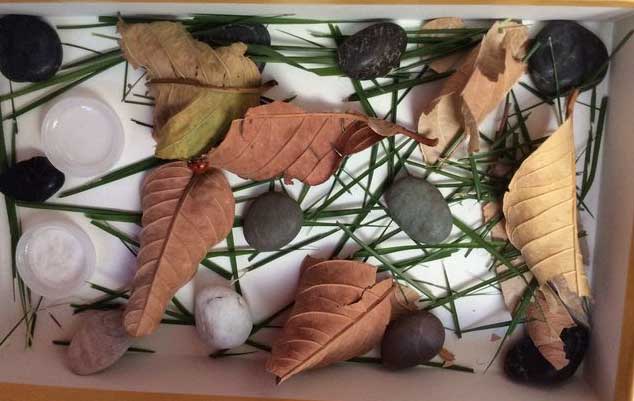
This is roughly how the ladybird breeding station should be equipped inside.
Important for the breeding station:
- Avoid direct sunlight
- the temperature in the breeding station should be between 20-25° C
- It is best to keep the breeding station far away from your grow box, as far as possible and in another room. Even if you give the ladybirds honey drops, water and sultanas, it is also important for breeding to regularly give them fresh branches with aphids or spider mites. It is wise to do this as far away from the grow box as possible. If you have infested cannabis leaves, these can of course also go into the grow box.
- Spray the cat grass in the breeding station with water 1-2 times a day.
- give the ladybirds fresh water every day.
- Do not put mouldy plant parts into the breeding station. Avoid mould growth and ensure good ventilation (:D also here). Mould can also harm the ladybirds.
- In summer, it is best to keep the grow station in a shady place outside, if it is not too hot. Avoid direct sunlight.
- Store the breeding station indoors (in winter or no garden) in a bright place, but without direct sunlight. Provide shelter in the breeding station (bark, bamboo pieces, cardboard rolls).
- Regularly and sufficiently give plant parts and leaves with aphids or spider mites.

Always provide ladybirds with sufficient water indoors and do not use deep containers, as they can drown.
The beetles mate and reproduce
When the ladybirds feel comfortable in the breeding station, the female lays up to 800 eggs after mating. The eggs are oval, light yellowish and are often found in crevices of plant parts or on the underside of leaves and are laid in groups. Ladybirds in Central Europe usually reproduce twice a year, so that the 2nd generation hatches in July or August and overwinters before laying its eggs again in spring. Normally, Central European ladybirds live for one year and overwinter only once.
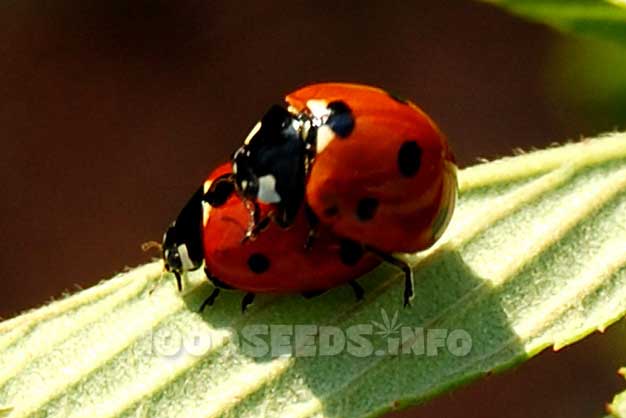
When the ladybird feels at home, it takes great interest in planting.
The ladybird breeding station is searched daily and very carefully for these eggs. When they are found, the corresponding sheet with the eggs is placed in an extra glass jar with a net lid and the eggs are separated. The date is written on the jar.
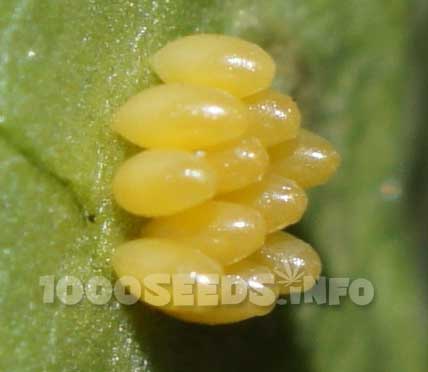
After about 1.5 weeks, the offspring hatch. These are black, elongated larvae, which visually still have little in common with the later adult ladybird.
These elongated larvae can now be placed in the grow box. Again, some plastic caps with water are placed, sultanas and a few drops of honey.
The voracious ladybird larvae can now get down to business and eat pests, if any are present. After the larvae have spent 20 days searching the grow box for pests and filling their bellies, they pupate.
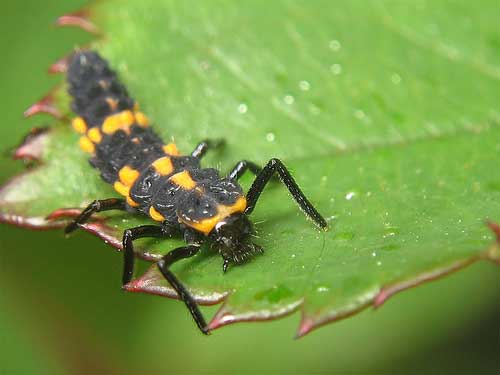
The larva of the ladybird still has little to do with the later ladybird, at least visually.
In the further course of development, the pupated ladybird hangs motionless on a leaf and is not active. This then takes about 10 days.
After 10 days, the bright red ladybird hatches and becomes an adult. Even in the adult stage, it eats many pests in the course of its further life, although not as many as when it was still a larva.
So now it starts all over again. If you are lucky and everything goes well, the ladybirds will multiply in your grow box and ensure a pest-free environment. It is best to set up a small ladybird house in the grow box.
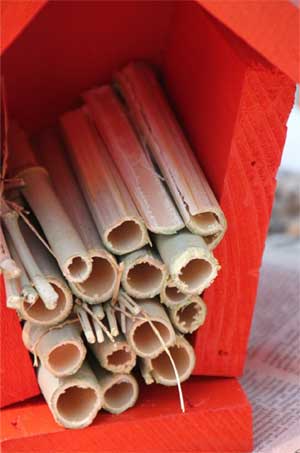
a small (e.g. self-made) ladybird house is hung in the grow box and provides the ladybird with protection and a place to lay its eggs.
If you notice that there are not enough ladybirds in the grow box, you can always add new larvae or adult beetles from your breeding station. Keep in mind that a fairly high number of animals is always necessary for it to work well. As a rule, it is most effective and necessary to keep adding new larvae.
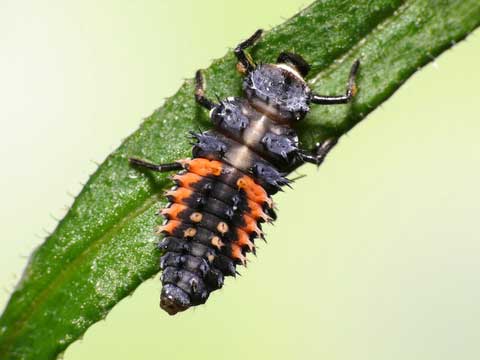
The larvae of the ladybird are particularly voracious.






